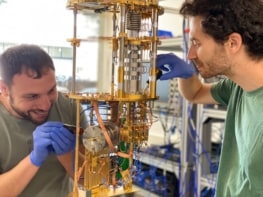Researchers have produced an organic light-emitting diode (LED) that is about 25 times more efficient than the best quantum-dot LEDs to date. The structure contains a single layer of cadmium-selenium quantum dots sandwiched between two organic thin films. Seth Coe and colleagues at the Massachusetts Institute of Technology believe that their approach could be used to fabricate other hybrid organic-inorganic devices (S Coe et al. 2002 Nature 420 800).
The advantages of organic LEDs are that they can be easily processed and can be combined with the excellent light-emitting properties of inorganic nanocrystals to produce real devices. Their output can also be tuned, which means that organic LEDs can be used to build full-colour displays of red-green-blue emitters.
For an LED to be efficient electrons and holes must be brought together in a small region so that they can recombine and emit photons without escaping or dissipating. The ideal LED contains three layers: a thin light-emitting layer that is held between a hole-transport layer and an electron-transport layer. The emissive layer should be thin to allow the electrons and holes from the transport layers to meet and recombine.
Coe and colleagues at MIT made a quantum-dot LED in which the light-emitting layer is only a few nanometres thick and contains nanocrystals of cadmium selenide – each about 3nm in diameter – that are equally distributed in the layer. The nanocrystals act as quantum dots.
The MIT team suggest that the electrons and holes in the structure are captured in the discrete energy levels in the quantum dots and then emit light by recombination. The bandwidth of the emission spectrum has a Gaussian profile that is determined by the uniformity of the size of the quantum dots — which can be controlled during processing. This is important because the luminescent spectrum could be ‘tuned’ to particular wavelengths by varying the size of the quantum dots.
Another advantage of this type of LED, say the team, is that every electron-hole recombination can produce a photon — leading to a possible 100% quantum efficiency at any visible wavelength. In many materials quantum statistics limit the efficiency to 25%.



